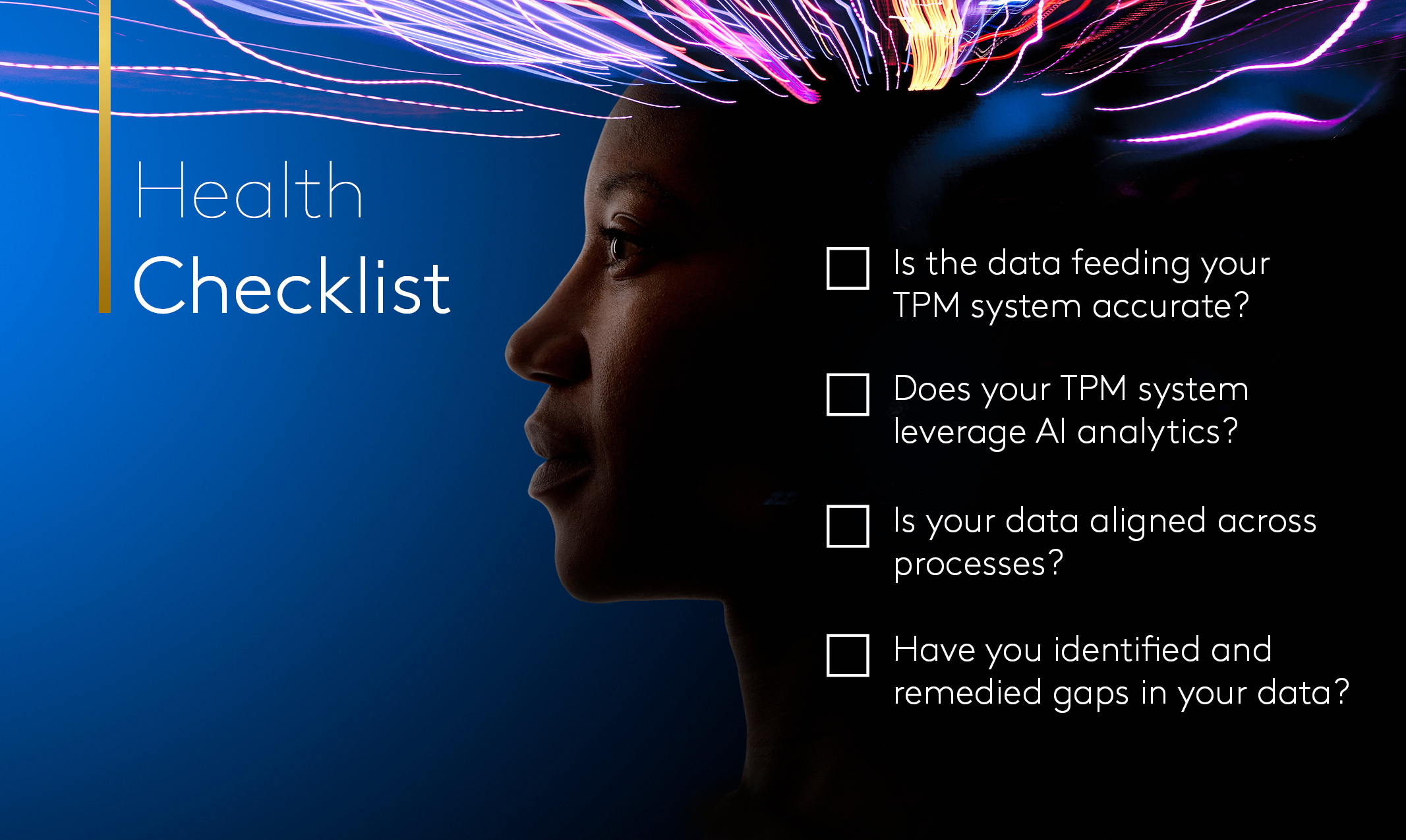Trade promotion management brings data to life. With powerful analytics, you can turn trade promotion insights into winning programs to drive your top and bottom lines.
To fuel growth, CPGs need to make sure the decisions they are making are informed, accurate, and actionable – which requires quality data and insights flowing to the right stakeholders in each step of the process. When TPM is supported by quality data that feeds AI-driven analytics, it automates descriptive, predictive, and prescriptive insights, which equip each team with a full-scope, future facing performance view. This allows each stakeholder to focus their attention on true value drivers.
Most manufacturers struggle with their TPM data. They lose valuable time and energy by manually uncovering performance markers and are ultimately left with little confidence in the accuracy of their findings. Unequipped with the right insights, suboptimal promotional plans are executed, resulting in subsequent margin and volume loss.
Yet, those who prioritize data and AI analytics as a core tenant of their TPM project experience unprecedented control and precision over trade promotion management levers and performance. They are able to harness the power of AI technology to not only save time through automation, but to reliably inform decision making to drive short-term wins and long-term value – resulting in a 2-5% increase in revenue and a 5-10% increase in trade spend ROI year-over-year.

Data
As you have probably heard in the industry or have even experienced, “garbage in, garbage out.” We all know high-quality data will yield accurate and reliable insights. But how does one achieve this desired quality of data? Do you have gaps in your data? Are there areas where datasets are misaligned between processes? Is there a balance between data richness and data granularity? Is data entered in a consistent and accurate manner? Is each team drawing data from a “single source of truth?” If there is not a plan in place to remedy the issues that come up, then the results are a direct and negative impact on your trade initiatives and ability to deliver against your company’s performance objectives.
Creating a successful data strategy is highly complex and requires time, resources, and expertise. Here are some recommendations that can lead to the most positive impact on your outcomes.
First, gather as much data as possible. The more historical data, (ideally the previous five years will provide the most relevant and useful market data) sources, and granularity you can incorporate, the deeper the AI engine will be able to reach to identify trends and relations. For example, an AI engine will be able to identify a performance difference between a leaflet promotion or a leaflet promotion coupled with a first page promotion. But the granularity and historical data is needed on the backend to not only produce those insights, but to do so at the highest accuracy rate.
The next step is to wrangle your data. Wrangling is all encompassing. It includes consolidating, cleansing, arranging, harmonizing, aligning, and massaging the data. The goal is to carefully prepare the data so that when each stakeholder is searching for an insight, the KPIs are already seamlessly computed and with a high degree of accuracy. One aspect of data wrangling is data consolidation; gathering all your historical data and organize it into as few sources as possible. The outcome is a reduction of compliance efforts and improved harmonization of data and processes. It helps align volumes and adjust promo mechanics based on shopper behavior more easily, therefore optimizing scenarios for you and your retailer, creating win-win scenarios all around. Though TPM implementations can be tight, it is recommended to dedicate as much time as it takes to data wrangling. Patience and scrutiny will pay dividends for years to come.
In addition to data wrangling, it goes without saying that leveraging artificial intelligence is essential to achieve the insights you seek. As time moves on, your data will build upon itself. Employ an AI analytics engine that will build intelligence as your data piles up. It’s important to carefully choose a solution, one that is predictive and prescriptive, runs on robust technology, and can handle complexity as you scale.
“RGM for me is about connectivity of data sets. It’s big data analytics driving better decision making and evaluation. So, when I am looking at the RGM journey, how can we leverage TPM tech to unlock TPM insights? TPM is forward looking and data critical. Insights before the money is spent... Bring in in AI to help key accounts with volume planning and bring in AI to look at data accuracy.” – Kellogg’s
People
Quality data and analytics in your TPM program will radically impact your margin and volume growth, but only if your teams trust and embrace the new solution and insights. Preparing to manage expected resistance to changes will be crucial to drive the intended value from your new TPM system.
Adding education around data and analytics into your change management program is a must. Conveying that AI functionality (along with data management capabilities) is a trusted way to correctly identify value drivers and achieve optimal promotional results should be top on your list. Systematically building an understanding around the impact that prescriptive insights, such as multiple optimized what-if scenarios, can have against margin or volume goals will create a strong incentive to drive adoption. Not to mention the automation involved, ridding them of tedious manual effort and freeing up time to focus on relationship-building with trade partners and activating value drivers.
Beyond conveying the overall value of AI when driving results, it’s important that your teams trust the AI by understanding how the analytics engine works and why inputting accurate data is at the crux of its functionality. By incorporating this into your change management program, you will clear the air of any doubts and pave clear next steps forward for your teams.
“It’s about providing a tool on the RGM journey that is adding value to the life of the Key Account Manager and not just entering data in that is going to be used just by the Supply Chain Team or Finance. Make sure there is an inherent value for the KAM to engage in the tool is key.” - Bel
Processes
When employing advanced analytics that leverage historical data, processes will gradually evolve. Initially, once the system is implemented, the AI will provide different prescriptive scenarios, and the user will then decide upon the scenario. In the not-so-distant future, the algorithm will crunch all the underlying levers to understand the reason behind the decision and automatically layer this intelligence into engine. With each promotion, the AI algorithm will be trained. These iterations compound over time, creating an overarching intelligence and single source of truth that learns preferences, makes intuitive suggestions, and automates based on behavior. Not only will accuracy rates increasingly improve, but so does alignment across processes, leading to improved collaboration and outcomes.
Best practices
Data and analytics should be a major focal point of your TPM implementation. Here are some best practices to help set you up for success in your next or current TPM endeavor.
Data input is the link that can break the chain – Data entry makes the difference between optimal and suboptimal outcomes. Communicate the importance of this step in the process and put measures in place to ensure that data is entered into the system as accurately as possible.
Build trust – Train your users on what AI is, how it works, and what it means for them. This will increase adoption and make sure your teams are leveraging the full power of the TPM solution.
Bring in the right stakeholders – Data scientists are experts on algorithms, methodology, paradigms, and procedures. But the meaning of the data is known by the right stakeholders and advisors. Make sure you have the right representation during the design phase.
Begin building your RGM program – Advanced analytics will enable revenue growth management activities. Trade promotion management is at the core of it and combined with the assortment and pricing levers can deliver unprecedent results.
To learn more about Data & Analytics for TPM, watch our webinar featuring Bel and Kellogg’s by filling out the form below.


